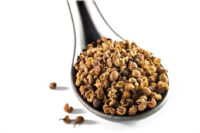From Mandarin to Szechuan
Many self-proclaimed experts in Asian cuisine will insist that there are eight styles of cooking in modern China, based on the eight geographic regions. For Western diners, the differences may be too abstract to be clearly defined. Even the most experienced of American-born “foodies” have trouble separating the cuisine of China into four styles—Northern, Southern, Eastern and Western. So many ingredients and techniques are shared by every region that, to the average American, the styles of Chinese cooking can best be divided roughly into two: Northern, or Mandarin style and Southern, or Szechuan (Sichuan) style.
Even these two basic styles can be hard to pin down. When asked to comment on the differences between the two, Seattle Post-Intelligencer food editor Hsiao-Ching Chou, an expert writer on Chinese cuisine, said, “As there is no region of China called Mandarin, and Szechuan is a province, I could not possibly make a culinary comparison.” Luckily for us, there are a few well-known chefs who can help us define the basic differences between Mandarin cuisine (Northern) and Szechuan cuisine (Southern).
Executive chef Gabriele Montevecchio of The Great Wall restaurant at the Sheraton Hotel in Beijing says, “The typical foods in Beijing and Szechuan are two completely different things. Beijing's cuisine (Mandarin) is not too spicy. It is full-bodied and rich. Southern Chinese (Szechuan) recipes are characterized by the Szechuan peppercorn. This pepper-spice is made into a paste, or just fried and infused in hot oil. Black beans served this way are everywhere in Szechuan province—from morning breakfast to lunch and dinner.
“Westerners rarely can tolerate such intensely spicy heat in foods. Most people can cope with spicy flavors from chiles, but not the Szechuan peppercorns! I have come to know many people in China, including many Westerners living in Szechuan and Chengdu (the capital of Szechuan province). After years, they still can not cope with the levels of spice used by the local people. The Westerners do come to love the spicy flavors, but they use them very mildly.”

An Expert's Insight
Celebrity chef Martin Yan may be America's most knowledgeable expert in Chinese cuisine. Born and trained in China, chef Yan has cooked professionally, taught, written about and lectured on the many styles of Asian cooking for more than 40 years. His knowledge of Chinese culinary techniques is unsurpassed. A personal friend of this contributor, chef Yan offers wonderful insight.At the time of this interview, chef Yan was performing a special dinner function for the high rollers at Harrah's Casino Resort in Reno, Nev., getting ready to fly immediately after to Beijing to participate in a Chinese culinary development project. He says of today's cuisine trends in China:
“Cuisine in China can be divided into to four basic styles, based on the four geographic regions of the country. These are North, South, East and West. However, actually we can separate the basic cuisines of China into two primary styles, Northern and Southern. The Yangtze River, famous for the Three Gorges, can roughly divide China. Everything below the river is Southern China. Everything above the river is Northern. Everything is different between the two regions: language, culture, religions and, of course, cooking styles vary from North to South.
“Northern Chinese cuisine also can be called Mandarin-style cuisine. The North comprises Beijing and all major cities north of the Yangtze River. The cooking of this region reflects the culture, climate, history and attitudes of the North. The main difference you will notice between Mandarin and Southern cooking styles is the saltiness. Mandarin cuisine uses salt to highlight the natural flavors of northern ingredients. You also will see a focus on wheat-based foods used as the cornerstone that meals are built around. Noodles and dumplings are an example of those delicious wheat-based Northern Chinese menu items. Flavors are pure and direct, often emphasized with the saltiness of soy sauce, either light or dark.
“Southern Chinese cuisine also can be called Szechuan-style cuisine for the purposes of this article. Though the Szechuan province is only one part of Southern China, its style of cooking is important enough and similar enough to other Southern Chinese styles and familiar enough to Western diners to represent Southern Chinese cuisine for this discussion.
“Szechuan cooking is more flavorful and more highly spiced than Mandarin-style foods. Szechuan peppercorns, dried and even pickled chili peppers, and garlic often are used to create intense flavors. As is seen in other hot, humid locations around the world, the style of eating has been flavored by the climate. People living in sultry climates everywhere have developed hot, spicy recipes. It seems the closer a people live to the equator, the hotter and spicier their local cuisine has become.
“Rice is grown more easily in the southern climate zone of China. Of course, rice is the staple food of Southern Chinese cooking. Mild-flavored rice also lends balance to the intense spiciness found in many Southern dishes.
“Universally throughout China, certain ingredients, flavors and spices are used. Both the North and South have found the value of garlic, rice vinegar and soy sauce. Ginger is found in every city in China. Scallions are a favorite ingredient for every Chinese cook. Sesame oil is used as a flavoring in every region.
“The basic cooking techniques are the same in almost every region of China. Stir-frying in a wok, steaming and deep-frying are found everywhere. However, the flavors and textures are very different from North to South. Mandarin cuisine is very different from Szechuan cuisine. Yet both are amazingly delicious! The answer is to try both and become familiar with both. We may find favorite dishes in one, the other or even both styles.”
Chinese Food in America
The huge wave of Chinese who immigrated to the U.S. in the 1800s came mainly from one Chinese region known as Canton. They created products that were Americanized versions of the foods they loved. Partly to please Western customers and partly due to the non-availability of authentic Asian ingredients, the tenacious new Americans created items and recipes like chop suey and the fortune cookie. The Cantonese also brought us dim sum, literally translated as “touch your heart” (these are a variety of delicious tiny pastries and dumplings that originated in China's teahouses). Pseudo-Chinese foods were all that most Westerners knew of Chinese cuisine until the end of the Vietnam War brought thousands of veterans home from extended tours in Southeast Asia. These returning veterans had experienced many exotic and delicious new recipes while fighting for our country and desired to continue eating these exciting flavors.Soon, top chefs all across America were beginning to experiment with a new style of cooking called fusion cuisine. Cutting-edge culinarians such as chef Norman Van Akin of Norman's restaurant in Coral Gables, Fla., and chef Charlie Trotter of Chicago were fusing the flavors and ingredients of China, Korea and Japan with the techniques and presentations of European cuisine. The intense, spicy cuisines of Southern China were now something to be explored. Szechuan-style foods became very popular.

Szechuan and Mandarin Cuisine
Szechuan cuisine evolved in China's largest province. The recipes preferred in this hot, humid and mountainous region became very different from other Chinese cooking styles. Foreign traders traveling along China's famous Silk Road brought outside influences to the cooking of this region. Religious missionaries brought the intense and flavorful use of spices seen in Indian cuisine. Chinese chefs soon began using Szechuan pepper as a primary flavoring addition. (Szechuan peppercorn also is the main ingredient in five-spice powder.) Spanish traders and missionaries introduced hot chilies to the region in the 1500s. Chefs in the Szechuan province began to incorporate powerfully flavored vegetables such as ginger, garlic and onions in almost every recipe. These cornerstone ingredients can be found in almost every region of China.As chef Yan has taught us, Mandarin cuisine can be said to be the cooking of Northern China, including Beijing. For many thousands of years, the Forbidden City was home to China's emperors and the capital of the empire. The chefs of Beijing have been blessed with visiting dignitaries from every corner of the world. These wealthy visitors often brought their own personal chefs, who brought their recipes, ingredients and techniques. Peking duck may be the most famous of the royal dishes created in this culinary melting pot.
Again, one sees there are some similarities between every culinary style in China. In addition to pork, other ingredients almost universal in Chinese cooking include green onions, garlic, ginger, rice wine vinegar, sesame oil, sesame seed and two types of soy sauce: light and dark.
By understanding both the similarities and differences between the two main styles of Chinese cooking most accepted by Western consumers, manufacturers will be able to create better and more successful new products. This will not only meet the future needs of customers; those manufacturers will profit by doing so.
Sidebar: Chinese Foods Now Friendlier to Developers
China is a huge country, with many regional cuisines that are difficult to identify and understand by many Western product developers. R&D people can find it hard to differentiate between the subtle variations in similar cuisines. Acquiring exotic/rare ingredients has been challenging in the past. Language and cultural differences have limited understanding and communication. Cultural bias has limited product acceptance. These challenges have made developing regional Asian products difficult until recently.Consumers' tastes and purchasing patterns are evolving. Chinese cuisine is becoming more acceptable and more appealing to an ever-widening section of the American population. This consumer desire presents an immediate opportunity. However, there are various styles of Chinese cuisine. What are the differences? What are the similarities? Which style will be most widely accepted by American consumers in the near future? Can we capitalize on this knowledge? Yes!
By becoming expert in Chinese cuisine, it is possible to predict future dining directions and create products to capitalize on those demands. Research chefs are prepared to create new products, flavors and recipes based on this knowledge, positioning many to profit from the opportunity.
—Chef J.
Northern Nibblings
In China's North, the freezing cold winters would seem quite familiar to many average Americans. Northern Chinese chefs tend toward hearty, filling recipes. Wheat is the staple grain in the area, as rice does not grow well there. Noodles made from wheat flour are another staple. Steamed dumplings and pancakes are seen on every menu. Lamb is very common in grassy northern China and also is the primary ingredient in Mongolian Hot Pot, a very traditional dish found everywhere in Northern China's cities.
Pork, however, is the universal meat of Chinese cuisine. Almost every region of the huge country uses pork frequently. One Northern dish, Mu Shu Pork, has become a familiar item on many U.S. menus. Mu Shu uses leeks, onions and garlic, wrapped in steamed pancakes, to create a filling and delicious entrée. It is characteristic of Northern-style cooking.
—Chef J.
Looking for a reprint of this article?
From high-res PDFs to custom plaques, order your copy today!









